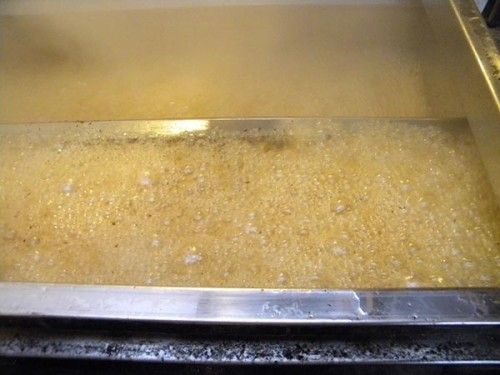And then it came.
After weeks of historic cold, the weather finally broke on March 30. There’s a comic strip that hangs on the wall of our sugarhouse, where a sugarmaker drills a hole in a tree and gets a squirt of sap in the eye; after he leaves, the one tree says to the other: “I’ve been saving that up since last March.” That’s kind of what this run feels like – like the trees had been saving up their sap through the cold and then they just let loose in one big deluge.
At first it was just the Hall bush that ran. Then Hall slowed down a bit and the Farm bush took center stage. Then, starting April 1, both bushes took off, and we’ve been boiling ever since. On April 1, 2, 3, we collected around 12,000 gallons of sap; the most we’ve ever done over a three-day stretch. In less than a week’s time we went from 8 percent of a crop to over 50 percent.
♦ ♦ ♦
I got an email earlier in the week from the folks at the Vermont Maple Sugarmakers Association, who were upset about Rolling Stone magazine’s alteration of an iconic drawing on a maple syrup can to open a story on heroin abuse in the state. The title of the email was “Inaccurate depiction of Vermont maple syrup,” which made me chuckle. (The idea of injecting syrup into one’s arm is indeed inaccurate.) Their point is that “it’s unfair to take an issue that affects our state and nation and pair it with the maple industry, an extremely important piece of our economy and an honest livelihood of many Vermonters.” They’re not the only ones who are upset. Do a quick Google search and you’ll find lots of Facebook posts and comment boards full of people railing against the magazine.
I thought the image was clever – if I were editor of Rolling Stone I would have run it in a heartbeat – but I don’t want to discount the anger people are feeling, either. The subtext here is that people don’t like the fact that their rural state is being rebranded as the face of what was, until recently, an urban problem.
This brings up the question of who we are – and it’s a question being asked not just in Vermont but everywhere in rural northern New England. We think of ourselves as rural people, our identities tied to this place. Many of us work the land, either literally or spiritually. Sugarmaking is the embodiment of this. Whether you’re the Branon family who tap 80,000 trees or our friend Dave D. down the road who taps one yard maple, sugaring ties you to the culture here, and the seasons, and the land itself. A literal taproot into the earth.
The Rolling Stone image was so powerful because the drug and the lifestyle it represents are so antithetical to this collective sense of place.
The New York Times recently ran a piece by Katharine Q. Seelye about Vermont’s drug problem, and these paragraphs seemed particularly illustrative:
“Many believe that part of the drug problem lies in the high conversion rate of single-family homes into multiunit rentals. The police say such units can be breeding grounds for drugs because of a well-established network, mostly of young women, who live in them and play host to out-of-town dealers. The dealers can make quick money by buying heroin in New York or Springfield, Mass., for as little as $6 a bag and selling it here for $30. About $2 million in heroin is trafficked every week in Vermont.
“If you’re a guy from New York, you can come here with 500 bags of heroin, sell it and sleep with three different women before you go home the next day,” said [Rutland Police] Chief Baker. Many of the women, he said, receive rent subsidies and food stamps and use heroin themselves. “The entire infrastructure is here for these guys to function, make quick money and leave,” he said.
Infrastructure.
Baker uses the word to refer to the drug pipeline, but he may as well have been using it to speak of the land itself. Forest becomes field, field becomes homestead, homestead becomes subdivision, the home itself becomes subdivided into multi-unit rentals. The rural way of life falters, the old ways break down, and in the void sprout asphalt and sprawl and these urban scourges.
Yes, the rural Northeast has plenty of its own problems. But there’s a context for things like rural poverty and alcoholism – we know these devils because we’ve co-evolved with them for as long as we can remember. We’re having a hard time dealing with this new invasive because it’s so “somewhere else” – heroin like honeysuckle. The point I’m trying to make with all this is that like invasive plants, we facilitate the drug’s spread by changes we make to the land.
If you walk down in the woods behind our sugarhouse, through a grove of maples that has been tapped for generations, across a trout stream where, for even longer, kids have gone each spring to catch speckled brook trout, you’ll come to a neighbor’s sugarbush. He called us Wednesday night and told us he caught some people in his woods after dark who were up to no good. Told us to lock our doors. Later that evening a state policeman showed up at the sugarhouse asking questions. I don’t know if any of this involved heroin. But people are on edge around here.
The sky was just splattered with stars that night, and a thin sliver of moon hung low in the west. Picture sweet steam mingling with those stars, a halo of yellow light around the sugarhouse door, the sound of a baseball game on AM radio coming from inside. Then at the end of the driveway, a police car…



Discussion *